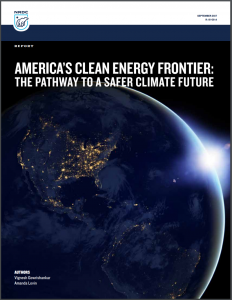Full Title: America’s Clean Energy Frontier: The Pathway To A Safer Climate Future
Author(s): Vignesh Gowrishankar, Amanda Levin
Publisher(s): Natural Resources Defense Council
Publication Date: September 1, 2017
Full Text: Download Resource
Description (excerpt):
To stave off the worst impacts of climate change, the world must limit warming to no more than 2 degrees Celsius above pre-industrial temperatures. The Intergovernmental Panel on Climate Change (IPCC) says this will require developed countries—especially the United States as the world’s second-largest emitter—to cut their greenhouse gas (GHG) pollution by at least 80 percent by 2050, relative to 1990 emissions levels.1,2 The Natural Resources Defense Council (NRDC) partnered with the internationally recognized consultant group Energy + Environmental Economics to determine whether, and how, the United States could achieve this target.
NRDC’s groundbreaking analysis demonstrates clearly that with bold action on energy efficiency, renewable energy, electrification of vehicles and buildings with clean power, and electric grid enhancements, the United States can reach its 80 percent by 2050 climate goal. Moreover, we can get there at a much lower cost than any comparable study predicts.
Between 2015 and 2050, our plan’s costs are just 1 percent more than current U.S. energy costs, but deliver benefits 7 times greater than these costs. This translates to average costs of $22 billion a year and more than $154 billion a year in environmental benefits—in extreme weather, heat waves, and climate-induced illnesses avoided. If we include resulting additional health advantages, the net benefits would be even greater. It’s notable that NRDC’s pathway incurs low additional costs cumulatively by 2050 compared to a scenario in which no action is taken, but costs less in 2050, and maybe the lowest-cost option beyond 2050. The additional expense arises from more up-front capital investments in clean and efficient power, appliances, and vehicles. But these technology investments result in significant and growing fuel savings that help offset the incremental costs over time. In fact, our scenario costs $30 billion less in 2050 than a no-action scenario. Lastly, while we did not model post-2050, our approach may be the least-cost option beyond 2050, thanks to the continuing fuel savings. Furthermore, there is no need for technological breakthroughs—we have the tools now. The United States can cost-effectively reduce GHG emissions with proven clean energy solutions, most of which are deployed at commercial scale today.
